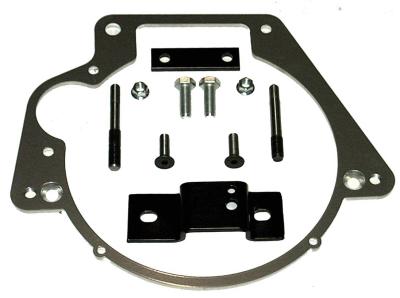Looking for more power? A common engine swap is to swap out the Suzuki Samurai 1.3L engine for a 1.6L engine from a Suzuki Sidekick or GEO Tracker.
Suzuki 1.6L Facts:
-
The 1.6L is a fuel injected engine and never came with a carburetor
-
The 8-valve 1.6L has throttle body fuel injection while the 16-valve has multipoint fuel injection
-
The 8-valve 1.6L is rated at 80hp.
-
The 16-valve 1.6L is rated at 99hp.
-
The 8-valve 1.6L engine can use the 1.3L intake and a carburetor
-
The 1.6L 16-valve will require the use of all the fuel injection components and require a complete rewiring
-
The 8-valve 1.6L head and 1.3L head are nearly identical. The 1.6L has bigger intake and exhaust ports
-
The 1.6L swap adds very little weight keeping the Samurai a very light and nimble trail machine.
You can re-use your stock 1.3L manifolds, flywheel and clutch with the 8-valve 1.6L as well. You’ll need to use the 1.6L starter and alternator.
When gathering parts for your conversion keep in mind that 1996 and up motors are OBDII and will not be smog legal for California. On 1996 and up donor vehicles you will need to get the second 02 sensor portion of the wiring harness. You will need the motor, wiring harness, everything attached to the wiring harness, instrument cluster and air cleaner assembly. Grab the catalytic converter if you can.
Trail Tough:
Trail Tough’s 1.6L conversion kit includes an engine adaptor kit, high pressure fuel pump, and modification of your donor harness completely color-coded labeled and ready install a well as modification of your speedometer. If you want to use the 16-valve 1.6L, you want the Trail Tough kit!
Check Out: www.trailtough.com
Parts Needed From a Sidekick or Tracker:
You’ll need the complete engine with all the hoses and pulleys. You’ll need the fan, starter, alternator, coil, air cleaner, exhaust manifold and head pipe. With 16-valve engines, you’ll need the engine wiring harness, everything attached to the harness, under dash wiring harness, ECM, instrument cluster and air cleaner assembly. Grab the catalytic converter if you can. The donor vehicles wiring harness will need to be modified for use in the Samurai as well as the Samurai speedometer which will need the speed sensor from the donor vehicle adapted to it.
The 1.6L 8-valve engine can also accept modifications such as the Thorley header, MSD ignition, and other great components to help soup up your new setup. Even without modification to your 1600 engine you can expect to gain up to 25 horsepower over the stock 1.3L motor using a fully bolt on kit.
Installation Overview:
1. The engine swap is easier if you remove the engine and transmission together. Remove all of the wiring, cables, lines and hoses from the engine. Remove the air box, disconnect and remove the battery, and label all the wiring and components so you know what it is later. Drain the radiator and transmission oil. Finally, remove the fan, shroud, and radiator.
The engine and transmission is removed by removing the (4) 14mm motor mount bolts, (2) 12mm transmission crossmember bolts, and the (2) 14mm bolts that hold the brace below the tranny. Make sure you remove the ground from the starter.
Once you begin hoisting the engine out, make sure the distributor does not hit the firewall and that the harmonic balancer pulley doesn’t hit the radiator support near the hood latch.
2. Once the engine and transmission is out, you can remove the starter and separate the engine and transmission. This is a good time to replace the clutch, pressure plate, and throw-out bearing.
3. Now you can install the adapter kit. This involves installing the adapter plate to the new engine and reattaching the Samurai transmission.
4. Now you can install the Sidekick/Tracker starter.
5. Install the new passenger side motor mount and drivers side motor mount shim.
6. Now you can drop the new motor and transmission in to the Samurai. The engine and transmission bolts back in to the stock locations.
7. Reinstall the Samurai radiator.
8. You’ll have to make custom mounts for the air box with mass air sensor. One side of the box bolts to the side of the fenderwell using the original air box mount. The other side will need to be braced with a piece of metal. You can use a piece of flat stock and bend it in to shape.
9. The ignition coil can be mounted to the firewall on the passengers side at the mounting location for the steel vacuum line that goes from the manifold to the brake booster. Remove the 10mm bolt and reinstall it through the coil bracket and the hard line mount with the coil wire facing the distributor. The distributor wire to the coil was about 6 inches too short so the coil wire from the 1.3 liter motor was removed and installed instead.
10. Now install the wiring harness you had modified by Trail Tough. Route the harness through the large grommet hole above the battery and into the passengers side kick panel where the ECM will be mounted. Mount the ECM securely using rubber grommets for isolators.
11. You’ll have to install the speedometer that you had modified by Trail Tough. This modification is necessary for your ECM to control the motor properly and it also keeps the sensor light from coming on.
12. Now you can install the ECM. Since the majority of the wiring is connected under the dash on the passengers side you should mount the ECM up high on the firewall behind the glove box. Some people have installed the ECM in an upside down Tupperware container to protect it from dirt and moisture.
13. You’ll have to install an electric fuel pump (with at least 45psi output) if your Samurai doesn’t already have fuel injection. You can do this by:
1. Getting a complete fuel tank from a 1990 or newer Samurai which has the pump already built in the tank.
2. Purchase a new electric fuel pump which could be mounted outside the tank under the body or on the frame rail.
a. You can use an external fuel pump from an 89 Ford F-150. It is a two wire hookup and accepts a 5/16 fuel line.
3. Cut the complete fuel pump mounting plate and pump out of a Tracker gas tank and weld it into the Samurai gas tank.
If installing the fuel pump on the underside of the body, mount it as high as you can so if a drive shaft lets go it won’t hit the pump. All lines need to be double hose clamped due to the higher fuel pressure.
14. For the fuel line connections, you can use high pressure rubber fuel line between the motor and Samurai hard line. Make sure you use fuel line clamps so they clamp evenly all around the hose without digging into the hose. Double clamp all the connections. Insert a fuel filter between the fuel tank and fuel pump.
The 16-vale motors fuel return line is 1/4-inch and needs to be 1/4-inch all the way back to the tank.
15. Run the fuel pump wiring into the engine compartment through the grommet above the battery and into the passenger compartment. Connect it to the fuel pump relay near the ECM.
16. Since the 1.6/16v is a taller engine, the front clip may have to be raised a little for proper hood clearance.
The Trail Tough kit includes replacement front body bushings to raise the front clip (hood & fender area). Some have added a 3/4-inch spacer to the body mounts up by the radiator support and a 3/8-inch spacer to the next ones back. Others have cut down the cable bracket, took off the support for the crossover tube, and adjusted my hood latch up as far as it would go and put some washers under the rubber stops to space them down. Using the Trail tough body bushings or body mount spacers is probably your best bet. Of course, if you have a body lift installed then you don’t even have to worry about it.

